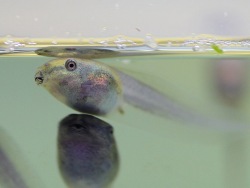Small Sri Lanka at the Primorsky Aquarium

Another breeding program held by the Aquarium has become a success: its common hourglass tree frogs (Polypedates cruciger) – an exotic species from the island of Sri Lanka – have produced their first brood. This tailless amphibian occurs only on a single island but in its native land it can be found almost everywhere: in dry and moist tropical forests, in freshwater swamps, in meadows, pastures and gardens. Hundreds of the common hourglass tree frog’s tadpoles, which will have metamorphosed into froglets by mid-February, make the terrarium at the Primorsky Aquarium look like tiny Sri Lanka.
This tree frog gets its name from the distinctive pattern on its back resembling a cross or an hourglass in shape. The pattern becomes lighter during dry periods and visibly darkens when the humidity increases. A pair of common hourglass tree frogs of the Primorsky Aquarium was to undergo this very coloration change. At first, the biologists reduced the number of daily misting sessions to simulate a dry season in the frogs’ enclosure, and then the amphibians were exposed to “rain”, which acted as a signal for breeding.
“Breeding in common hourglass tree frogs starts with a male and a female going into amplexus – a process that, to onlookers, seems to be an embracement,” said Artyom Gerasimenko, Principal Specialist at the Tropical Rain Forest Department. ““Future parents secrete a specific substance and whip it up into a foam to build a nest for egg laying. Nest-making is an amazing feature, typical of all species in the genus Polypedates. They usually construct their nests at night and attach them to vegetation over a pool. Our common hourglass tree frogs made their first nest measuring 8 cm wide and 10 cm high. Some motion in it was noted on the second day after the eggs were deposited.”
Initially, the foam nest is rather thick in structure but within a week it becomes fluidized, letting the hatched tadpoles fall into the water below – thus, they move into the next stage of their development.
General Information
Besides being an endemic species to Sri Lanka, the common hourglass tree frog is one of the island state’s symbols. A while back the amphibian was depicted on the 10-rupee banknote. At the end of the last century the banknote was withdrawn from circulation, and now it has a high numismatic value.

